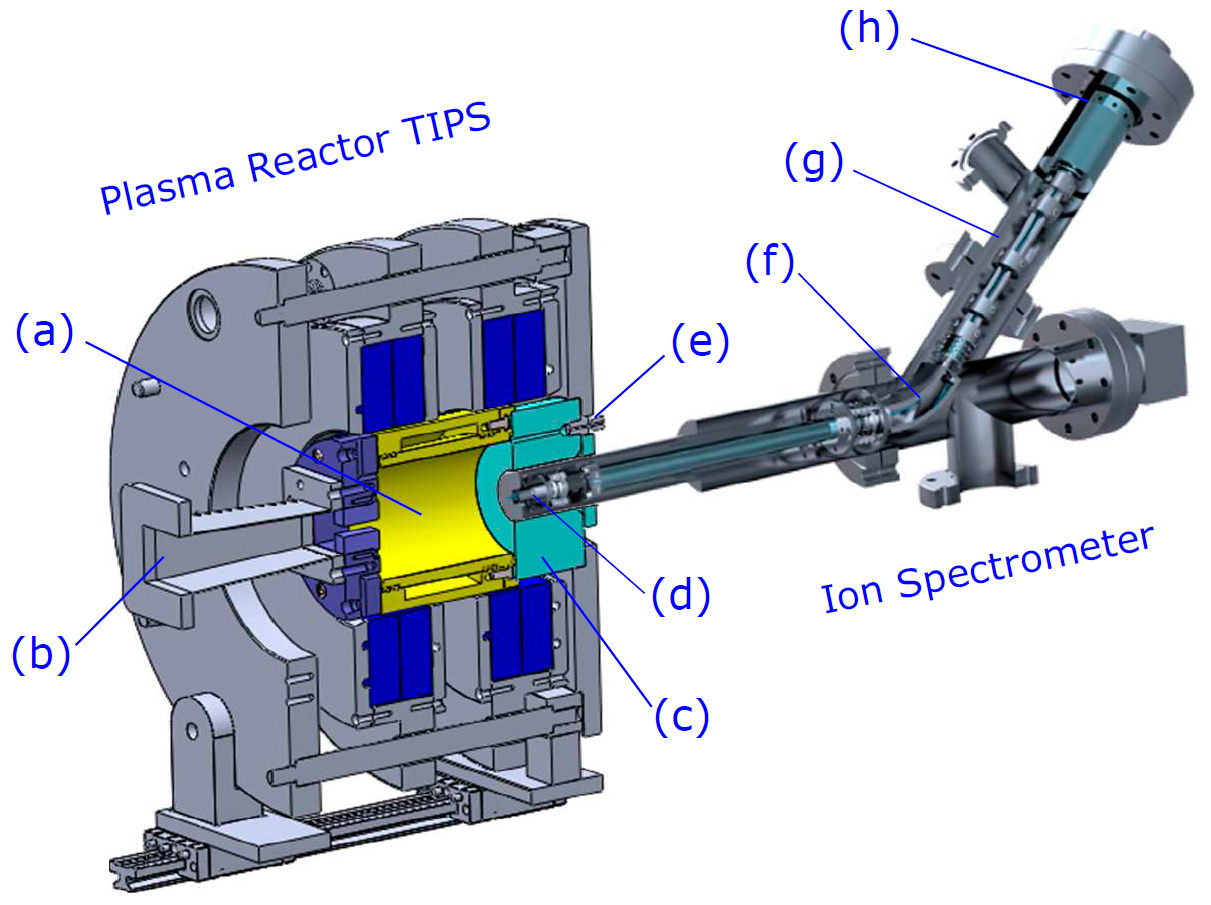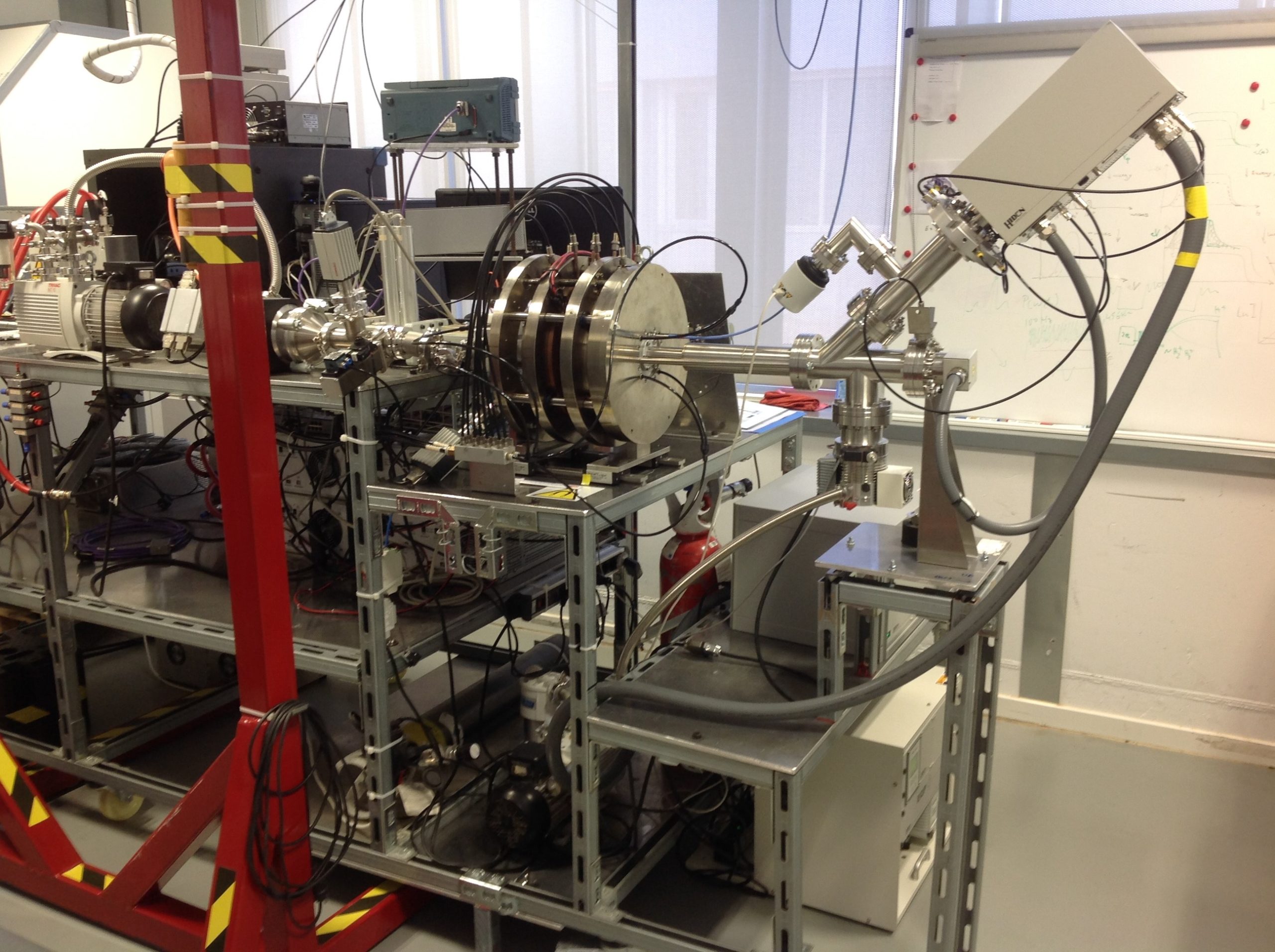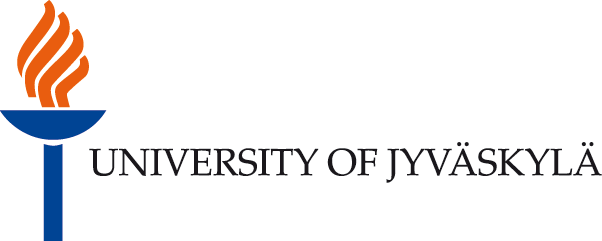TIPS (Test-bench for Ion Source Plasma Studies) is a 2.45 GHz Hydrogen Electron Cyclotron Resonance (ECR) plasma generator designed to be used as a flexible device to study the relationship between the engineering design of the source and the physical parameters of the generated plasma [1-5]. In many occasions, ECR plasma generators are used in ion sources for multiple applications both in scientific and industrial developments. The characteristics of the beam that can be extracted from the source are deeply related to those of the plasma and, for this reason, the understanding of the plasma parameters is a key point to design better and more reliable ion sources.
One of the most interesting parameters of plasma from the scientific point of view is the energy distribution associated to the different ion populations present in it: The Ion Energy Distribution Functions (IEDFs). The IEDFs are of interest for several reasons, e.g., to understand the ion dynamics within the discharge, compare the rates of certain plasma chemical reactions especially in discharges consisting of molecular species, and to predict the thermal properties of the extracted ion beams.
A Hiden Plasma Ion Mass Spectrometer model EQP [6] was used to measure the Ion Energy Distribution Functions of H+, H2+ and H3+ ions in the plasma generated in TIPS. The Ion Mass Spectrometer uses a 45o energy sector analyzer in tandem with a quadrupole mass analyzer. This configuration allows us to select a particular ion (mass and charge) to measure the corresponding energy distribution. It is capable of running energy scans from 0 to 100 eV at 0.05 eV increments/ 0.25 eV FWHM. The IEDFs were obtained every 5 μs with 1 μs time resolution during the entire pulse duration [7].

Figure 1. Plasma reactor and Ion Mass Spectrometer: plasma chamber (a), microwave coupling system (b), diagnostics port (c), fiber optics feedthrough (e) and ion spectrometer probe (d).
Figure 1 shows the spectrometer attached to the plasma reactor. The plasma reactor was operated in pulsed more at 100 Hz with 1 ms pulse width, the Hydrogen pressure inside the plasma chamber was set to 3.8 x 10-3 mbar while the pressure inside the instrument was kept between 10-7 and 10-8 mbar to guarantee the collision-free transport of the ions enabling proper working conditions for the secondary electron multiplier (SEM).

Figure 2. A general view of the set up.
Consecutive IEDFs where obtained during the plasma pulse. Assuming a shifted Maxwellian velocity distribution the evolution of the ion temperature can be calculated. The positive shift of the curve is due to the plasma potential that gives the particles entering the energy analyzer a longitudinal drift velocity towards the detector. The ion temperature reached 0.5 eV during the breakdown, then decayed to 0.2–0.4 eV in approximately 150 μs, and afterwards, it follows a monotonic increase to reach a value of 0.7 eV. Finally, a sharp peak reaching 1.75 eV in coincidence with the trailing edge of the microwave pulse was observed. Knowing the ion temperature, it is possible to predict the emittance of a beam extracted from this plasma [8]. The calculated normalized emittance during the steady-steady part of the pulse was 0.1 mm mrad which is in good agreement with well-known ion sources such as TRIPS [9] or TRASCO [10].
In the near future the group is planning to carry an extensive study of the IEDFs evolution during the plasma pulses under a wider range of different conditions.
[1] O. Cortázar, A. Megía-Macıas, O. Tarvainen, T. Kalvas, and H. Koivisto, Rev. Sci. Instrum. 87, 02A704 (2016).
[2] O. Cortázar, A. Megía-Macías, O. Tarvainen, A. Vizcaíno-de Julián, and H. Koivisto, Plasma Sources Sci. Technol. 23, 065028 (2014).
[3] O. Cortázar and A. Megía-Macías, IEEE Trans. Plasma Sci. 44, 734 (2016).
[4] A. Megía-Macías, O. D. Cortázar, and A. Vizcaíno-de Julián, Rev. Sci. Instrum. 85, 033310 (2014).
[5] O. Cortázar, A. Megía-Macías, O. Tarvainen, T. Kalvas, and H. Koivisto, Rev. Sci. Instrum. 86, 083309 (2015).
[6] HIDEN Analytical Ltd., see http://www.hidenanalytical.com/ for more details on the Plasma Ion Mass Spectrometer.
[7] A. Megía-Macías, O. D. Cortázar, O. Tarvainen and H. Koivisto. Physics of Plasmas 24, 113501 (2017)
[8] V. Toivanen, H. Kalvas, H. Koivisto, and J. Komppula. J. Instrum. 8, P05003 (2013).
[9] L. Celona, G. Ciavola, S. Gammino, F. Chines, M. Presti, L. Ando, and X. H. Gou, Rev. Sci. Instrum. 75, 1423 (2004).
[10] P.-Y. Beauvais, R. Ferdinand, R. Gobin, J. M. Lagniel, P.-A. Leroy, L. Celona, G. Ciavola, S. Gammino, B. Pottin, and J. Sherman, Rev. Sci. Instrum. 71, 1413 (2000).
Project summary by: O.D. Cortázar, University of Castilla-La Mancha, Ciudad Real – Spain
Paper Reference: Megía-Macías, O. D. Cortázar, O. Tarvainen, and H. Koivisto (2017) “Time resolved measurements of hydrogen ion energy distributions in a pulsed 2.45 GHz microwave plasma” Physics of Plasmas 24, 113501 DOI: doi.org/10.1063/1.5001488
 |
 |
 |
Hiden Product: EQP
Project Summary Reference: AP-EQP-0011
To find out more about these products visit the EQP product pages or if you would like to contact us directly please Send us a Message.

